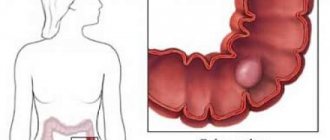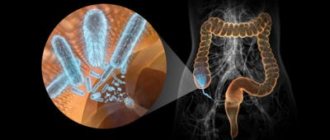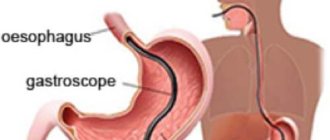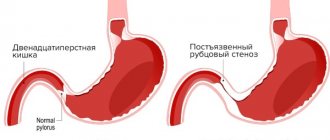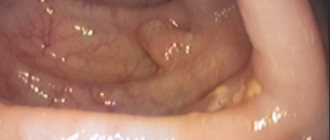Chronic inflammatory processes in the upper gastrointestinal tract in most cases lead to persistent damage to tissue structures. One type of tissue transformation is pathological proliferation of the mucous membrane with the formation of a polyp.
Many people are asymptomatic. Therefore, polyps are often an incidental finding during a routine endoscopic examination for another reason. If a formation is detected in the stomach, removal of the polyp is often recommended, because such changes can lead to adverse consequences, for example, malignancy (transformation into a malignant tumor), bleeding.
Is it necessary to remove a polyp in the stomach?
When a polyp is identified in the upper parts of the digestive tract, the doctor and patient are faced with the question: what tactics should be chosen? The treatment method depends on the data obtained as a result of FGDS with a biopsy.
Polyp in the stomach: what is it, is it dangerous, how to treat
A conservative approach with dynamic observation is used if the size of the formation does not exceed 5 mm and is not accompanied by malignant degeneration of surrounding tissues. If the value is 6-9 mm and it does not bother you, a decision is made based on clinical and histological data. In this case, drug therapy is prescribed followed by endoscopic monitoring after 6-12 months.
Surgery is necessary when the size of the formation is more than 1 cm. Its location in the area of the pyloric and cardiac sections of the stomach is also unfavorable - polyps can interfere with the normal movement of food into the underlying sections.
How long the preparation for removal and the operation itself will take depends on the chosen method of surgical intervention, the general condition of the patient, concomitant pathologies and the risk of complications. The technique is determined taking into account the size of the formation, the number of polyps, histological type, and the presence of metaplasia of the mucous membrane around the pathological area.
Symptoms of polyp formation
Content
- Symptoms of polyp formation
- Is surgery necessary?
- Treatment tactics
- Postoperative complications
- Rehabilitation
The early stages of polyp development are completely asymptomatic. If the neoplasms provoke gastritis or other gastrointestinal diseases, then a number of classic signs are observed, which mainly appear immediately after eating or after an hour or two: broken stools; flatulence and belching; vomiting and nausea; increased salivation; decreased appetite; dull and aching pain in the abdomen; feeling of fullness in the stomach; heaviness in the stomach area.
If you do not pay attention to the symptoms in the early stages, in the future it will be accompanied by pain in the lower back or shoulder blades, general weakness, and fever. Larger polyps can cause bleeding, which will lead to severe vomiting of blood. After the polyps grow into the duodenum, cramping pain in the abdominal area and under the breasts may occur.
Removal methods
At the present stage, doctors perform operations that do not require abdominal intervention. The procedure is performed using an endoscope. This approach is minimally invasive and relatively safe.
How is a polyp removed from the stomach?
The following methods are used:
- Electrocoagulation using an electrosurgical unit.
- Resection of the polyp in the submucosal layer.
- Dissection of the formation in the submucosal layer.
The first method is used for single formations of small size, which are not accompanied by pathological changes in the surrounding tissue.
The second option is indicated for formations with a wide base.
The latter method is used when there are flat and creeping formations that cannot be captured with a loop, including if the mucous membrane around the lesion shows signs of metaplasia.
Some clinics offer laser polyp removal. But at present the method has not found wide application.
Clinical manifestations
In the early stages of development, the developing gastric polyp of any structure manifests itself weakly or not at all. Considering that growths appear against the background of other concomitant pathologies, for example, gastritis or peptic ulcer, symptoms characteristic of their exacerbation may appear.
The main signs of gastric polyposis are:
- Dyspeptic disorders (nausea, diarrhea, vomiting);
- Stomach pain, discomfort;
- Heartburn, bloating;
- Weight loss, loss of appetite;
- The appearance of occult blood in stool tests.
Important ! In case of strangulation of polyps or their damage, the pain is acute and is rarely relieved by medications. Here patients are forced to seek emergency care.
How to prepare
Before the intervention, you should undergo an examination and consult with the doctors who will participate in the operation (surgeon and anesthesiologist). According to indications, consultations with narrow specialists (cardiologist, endocrinologist and others) are prescribed.
You will need the results of the following research methods:
- general blood and urine analysis;
- coagulograms;
- ECG;
- FGDS.
The surgeon examines the data to determine the method of intervention. The anesthesiologist finds out the medical history and examines the patient to eliminate possible risks during the operation.
Preparation for endoscopic removal includes the following recommendations:
- Avoid eating 12 hours before the procedure.
- Allow to drink some water no later than 2 hours before treatment.
- You must not smoke on the day the intervention is scheduled.
- Remove from the diet within 48 hours spicy foods, smoked meats, mayonnaise, baked goods, whole grains, broths, sauces, fatty meats, and mushrooms.
Important!
In women during menstruation, it is better not to undergo elective surgery, given the risk of bleeding.
Rehabilitation
Be sure to see a doctor after 2 weeks for a follow-up examination. After abdominal surgery, control diagnostics are prescribed after 30 days. It is important after the procedure to adhere to a diet without fatty, spicy, bitter, sour and heavy foods for at least 12 months (table No. 1). After abdominal surgery, you should not lift heavy objects; it is recommended not to make sudden movements or overstrain the abdominal area for a month.
More fresh and relevant information about health on our Telegram channel. Subscribe: https://t.me/foodandhealthru
We will be grateful if you use the buttons:
Removal of polyps in the stomach using the endoscopic method
A gastroenterologist studies FGDS data with biopsy. The specialist decides whether the patient can do without surgery or whether it is necessary to resort to surgical treatment. The choice of treatment tactics depends on the morphological characteristics of the formation, its size, and the condition of the surrounding tissues. Removal of a polyp in the stomach using the endoscopic method is carried out in three ways.
What is a hyperplastic polyp of the stomach and how to treat it
During electrocoagulation, after inserting the device through the mouth into the stomach, place the instrument on the unchanged tissues under the formation on the leg and carefully tighten the loop. Before this, a solution of indigo carmine blue is injected into the base of the submucosal layer of the polyp to prevent perforation and visualize the vessels. Then coagulation is performed. Its effectiveness is evidenced by a defect with the formation of a “white scab”.
Large polyps on a wide base, including formations that occupy a significant area, are eliminated by resection. The operation is performed in two stages. First, a “hydrostatic cushion” is created to separate pathological tissue from healthy tissue. Then a radical intervention is performed.
To do this, a circular incision is made and polypous tissue is excised.
Endoscopic dissection is performed if cancer is suspected in the polyp bed. The formation and mucous membrane are removed under constant visual control. The technique is more complex and requires good surgeon skills. Because this option can cause complications in the form of bleeding.
Attention!
The more complex the surgery, the more medications may be needed during the early recovery period.
How long does the operation take?
When removing a polyp with an endoscope, the manipulation itself takes 5-7 minutes. If a biopsy is necessary, the time is extended to 20-30 minutes. Endoscopic removal is surgery. Therefore, the duration of surgery depends on the complexity of the case. If the course is favorable, experts recommend being under medical supervision for 2-4 hours after endoscopic removal. The patient is advised to arrive 2 hours before the procedure.
Endoscopic surgery to remove a polyp lasts on average 30 minutes. If the case is complex, the time is extended to 1-1.5 hours.
Important!
To prevent bleeding during surgery, targeted coagulation of blood vessels is used.
Treatment after removal of polyps in the stomach
The endoscopic method is a gentle operation. Patients rarely experience pain after the intervention. Rehabilitation after removal of polyps in the stomach includes diet and restriction of physical activity for two weeks. Anticoagulants and antiplatelet agents are stopped for five days.
Carefully!
It is recommended to avoid air travel for 7 days.
Treatment in the early postoperative period is prescribed only in case of complications. However, in the future they resort to correction with drugs if there is an inflammatory process with impaired secretory and motor function. Medicines are prescribed taking into account the etiological and pathogenetic factors of the disease.
Depending on the method of removal and the condition after removal of the formation, the patient may be under observation in the hospital for 1 to 5 days. If pain does not bother you and there are no complications, the patient can be discharged after 24 hours. In the event of an unfavorable development of the situation when drug assistance is necessary, the duration of stay in the hospital is determined individually.
How to eat
The mucous membrane is restored with different types of surgical intervention from 10 to 30 days. Therefore, diet after removal of a gastric polyp by endoscopic method is very important.
A fasting break is recommended on the first day. You can drink still water after 3 hours in small sips, unless otherwise advised by your doctor. 24 hours after removal of the polyp, you can eat small portions. Vegetable decoctions, weak broths, jelly, and liquid mashed potatoes are allowed. After a few days, the diet is expanded to include protein products with the addition of vegetable fats. Give boiled or mashed steamed food. A strict menu is followed for a month. Then they move to table number 5.
What foods should you not eat?
Don't forget about prohibited products
After removal of the polyp, it is strictly forbidden to consume some foods, as they can cause irritation of the mucous membrane of the gastrointestinal tract and provoke complications. Seasonings or spices should not be added to dishes and it is important to monitor the amount of salt consumed. It is prohibited to use:
- fatty, fried and spicy foods;
- smoked meats, pickles, marinades;
- milk;
- coffee;
- carbonated drink, juice in a package;
- legumes;
- fresh baked goods;
- sausage.
Advice: poor nutrition and consumption of prohibited foods immediately after gastric surgery can lead to the formation growing again, and therefore diet helps reduce this risk and avoid many complications.
Proper nutrition helps get rid of the main cause of the development of a benign tumor on the mucous membrane of the gastrointestinal tract (frequent inflammation of the mucous membrane). A diet containing healthy foods promotes the rapid restoration of epithelial cells and stops the growth of repeated tumors.
Possible consequences
Complications in the early postoperative period are rare. An unfavorable outcome is associated with the occurrence of bleeding. This development of events directly depends on the following criteria:
- size of the formation - significant tissue proliferation increases the risk of complications;
- thickness of the pedicle - a feeding vessel can pass through a wide pedicle;
- type of polyp - creeping and diffuse forms increase the likelihood of perforation (rupture of the organ wall).
The long-term consequences of polyp removal are a relapse of the disease with the appearance of new formations. Therefore, periodic endoscopic examinations are required within a year after surgery.
Reviews
The modern approach to treatment shows that the majority of patients who have undergone minimally invasive surgery feel satisfactory. Adverse effects are rare. This allows you to reduce the time of hospital stay to 2-3 days. Reviews of polyp removal in the stomach indicate endoscopic methods.
Oleg, 54 years old:
“We discovered a glandular polyp during a routine examination. I have been suffering from chronic gastritis with high acidity for a long time. The doctor said it was necessary to remove it. Because it can continue to grow and cause unpleasant manifestations. We were referred to a surgeon who provides paid surgical treatment. The doctor discussed all the issues with me. He told me that the intervention would be performed endoscopically under general anesthesia and gave recommendations regarding restrictions before the procedure. The operation went well; there was moderate pain after removal of the polyp, which went away on its own. I followed the diet for 3 weeks. There were no complications."
Marina 61 years old:
“For a long time I had been bothered by pain in the upper abdomen after eating, it was bearable, and I did not contact a gastroenterologist. Previously, the diagnosis was made: chronic gastroduodenitis, with increased secretory function. Received treatment. When the symptoms worsened, she was treated according to the old regimen. When the pain began to bother me more often, I went to the doctor. FGDS revealed a polyp measuring 8.8 mm in the antrum. After preparation, the surgeon removed it with an endoscope. The price of the operation was 8,500 rubles. Given his age, he was left in the hospital under observation for 3 days. Now I feel much better. No complaints. It was recommended to return for a follow-up examination in 6 months.”
Elena, 57 years old:
“During endoscopy for chronic gastritis, a hyperplastic polyp was discovered. A biopsy was performed and it turned out that there were changes in the surrounding tissues. The polyp and part of the tissue were removed. She spent 5 days in the hospital, because bleeding began during the operation. Coagulation and therapy were performed. IVs were prescribed. I feel great now. The doctor warned that rehabilitation and dynamic monitoring would be required.”
